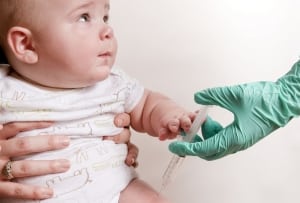 Taking your child’s temperature is an important part of determining how serious some illnesses are. Fevers indicate a normal immune response to infection. They usually go away within 3 days and are a good sign that your child’s immune system is working. However, extremely high fevers can indicate a more serious medical issue.
Taking your child’s temperature is an important part of determining how serious some illnesses are. Fevers indicate a normal immune response to infection. They usually go away within 3 days and are a good sign that your child’s immune system is working. However, extremely high fevers can indicate a more serious medical issue.
As a general rule,
-
newborns (under 1 month) should be taken to the ER for a temperature over 100.7° F
-
older kids should be taken to the ER for a temperature over 103.5° F (check first to see if they are responsive to fever reducers like Tylenol or Motrin)
Any other fever is usually not serious and you can decrease your child’s temperature at home. Use a fever reducer like Tylenol or Motrin, cold compress, and lots of fluids. Trust your instincts. As always, call your pediatric provider if you’re uncertain about your child’s fever. For more information, visit our Emergency Room blog or contact your provider.
Choosing the Right Temperature-Taking Method
It’s important to choose the right method in taking your child’s temperature. For example, an incorrect reading can take you to the ER when you don’t need to. Conversely, a wrong reading can also cause you to ignore a potentially serious fever.
When taking your child’s temperature, avoid using a mercury thermometer. Mercury poisoning can be dangerous for yourself and your family. For more information on mercury in your thermometers or household items, visit the EPA’s website.
Digital Thermometers
Digital thermometers are the most reliable method of taking your child’s temperature. They are used rectally, orally, or axillary (under the armpit). Armpit and rectal readings can be used for infants that are too young to hold a thermometer under their tongue.
Tips for Taking Your Child’s Temperature Orally
- Clean your thermometer. Use soap and water or rubbing alcohol and rinse with cool water.
- Make sure your child hasn’t had a hot or cold drink 15 minutes before taking their temp.
- Do not use a glass thermometer as it may break when your child bites down.
- Position the thermometer as far back in the mouth as is comfortable, under the tongue.
- Hold the thermometer in place for the recommended period of time, or until it beeps.
For axillary (armpit) readings, place the thermometer at the center of your child’s armpit. Hold their arms snug against their body and leave everything in place for up to four minutes, or until it beeps. Infants cannot keep an oral thermometer under their tongues, so the armpit reading usually works best. We don’t recommend the rectal method for your infants due to the tendency for inaccurate readings. However, some find this is the easiest way to get an exact reading for infants.
Rectal Reading
Use a regular digital thermometer or purchase a rectal thermometer, which has a larger bulb. It’s important to clean it well with soapy water or rubbing alcohol, and rinse with cool water. Firstly, the best way to position your infant is by placing them on their back with their knees bent. You can choose whether or not to coat the tip in petroleum jelly. Insert the thermometer into the rectum about 1/2 inch (1.2 cm) to 1 inch (2.5 cm). Hold it for about 2 minutes, or until you hear a beep, then read the temperature. Clean the thermometer after every use and never use the same thermometer for both rectal and oral readings.
Surface Temperature Thermometers
Taking your child’s surface temperature typically results in abnormal readings. These methods are completely inaccurate for infants and unreliable for all other ages. Surface temp thermometers are very easy to use incorrectly. This user-dependent nature of the surface temperature thermometer results in unreliable readings at home. Studies show that digital thermometers outperform infrared, tympanic, and temporal thermometers.
Infrared thermometers are sometimes used to take athletes’ temperatures while on the field. However, a recent study found this method to underestimate temperatures. The research revealed that these thermometers were valued for their convenience over their accuracy.
The temporal artery thermometer reads infrared heat from the temporal artery that runs across the forehead. This method does not work for infants under 3 months. Temporal artery thermometers are very user-dependent and imprecise readings are common.
The tympanic thermometer reads infrared heat waves in the ear. This method is inaccurate for babies under 6 months. It is unreliable for older children and is also very user-dependent. Using the thermometer correctly is difficult, as it must be positioned correctly in the ear canal and earwax can alter the reading.
An inaccurate temperature reading can cause parents to ignore a serious fever or go to the ER unnecessarily. We at Growing Healthy Together find that the regular digital thermometer works best when taking your child’s temperature. Other thermometers are user-dependent and not always correct. A core reading with a digital thermometer is more accurate than a surface reading. Digital thermometers are usually significantly cheaper, too!
For comments or questions, respond to this blog or contact us!







